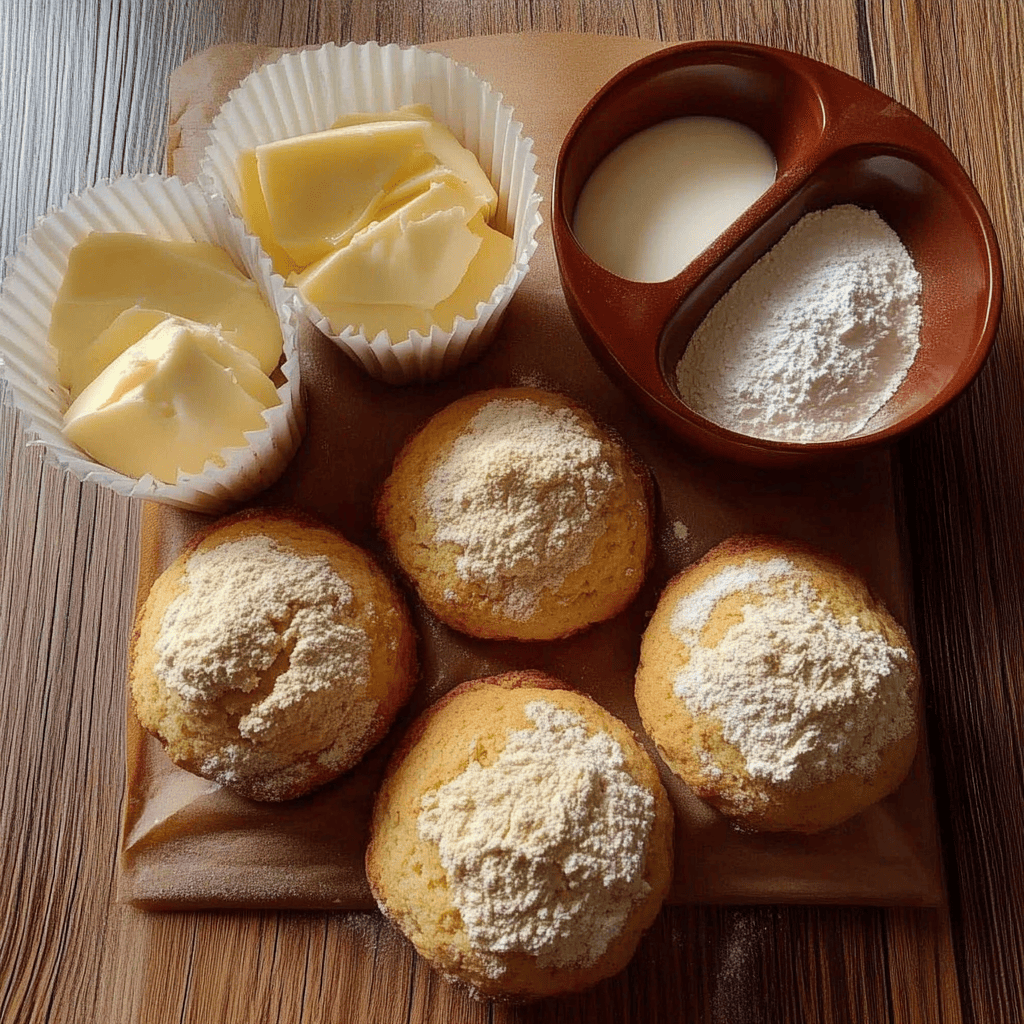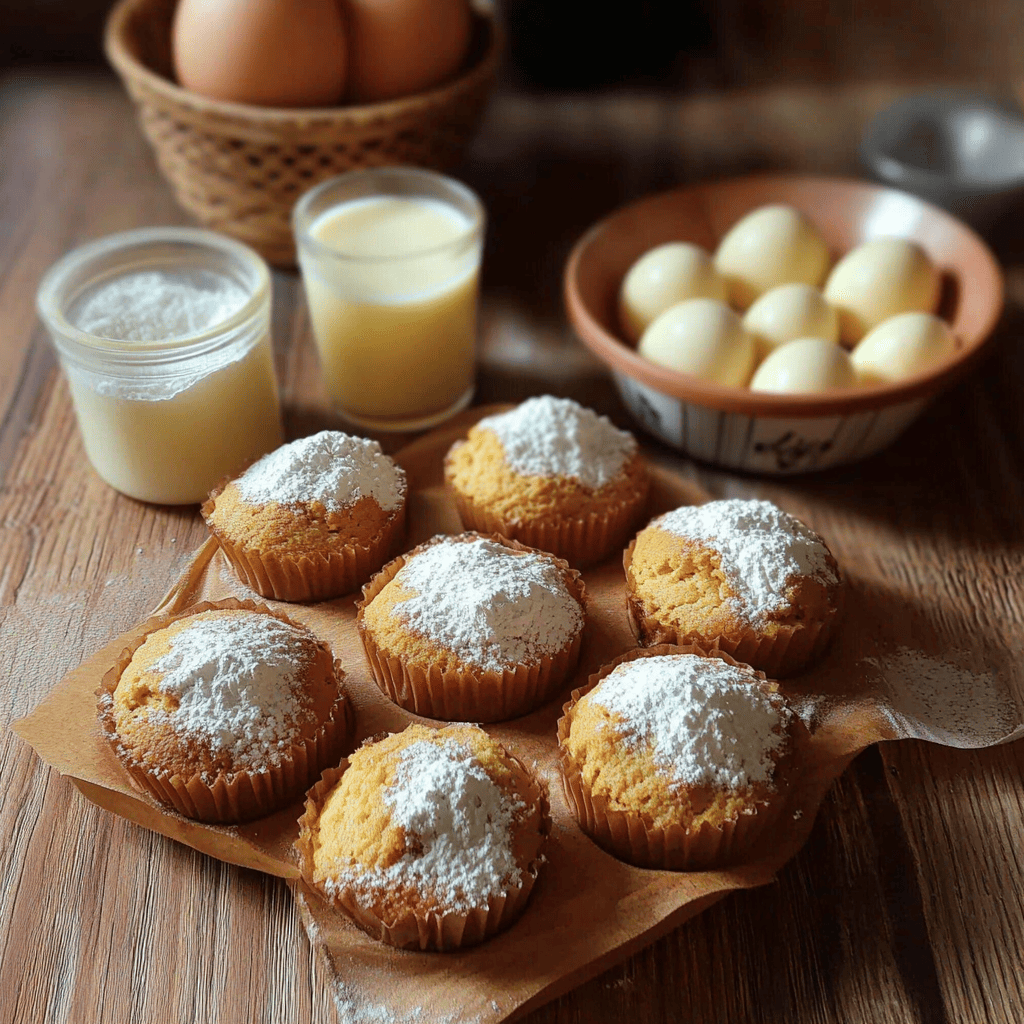Mantecadas: A classic pastry
Introduction
Mantecadas are a delicious, fluffy, sweet bread roll popular in traditional pastries in many countries. Their soft texture and delicate flavor make them a perfect accompaniment to coffee or tea, making them ideal for breakfast and snacks. Although their origin is associated with Spain, specifically the Astorga region, they have evolved into different versions over time and have become a classic in many cuisines around the world.
Mantecadas are a classic pastry, known for their fluffy texture and sweet, mild flavor. This bread, similar to a muffin but with a denser, butterier crumb, is a perfect accompaniment for breakfast, a snack, or simply to enjoy with a cup of coffee or tea.
What makes mantecadas special is their simplicity in preparation and the versatility of their ingredients, allowing them to be customized with different flavors and textures. Although the basic recipe is made with flour, eggs, sugar, butter or oil, and vanilla extract, there are variations that include nuts, citrus zest, chocolate chips, or spices like cinnamon.
This dessert, originally from Spain, has transcended borders and become a popular choice in bakeries and homes in many countries, especially in Latin America. In Mexico, for example, mantecadas are found in almost every bakery and supermarket, making them a delicious and affordable option to share with the family.
Making mantecadas at home not only guarantees a more authentic and fresh flavor, but also allows you to adapt the recipe to your personal tastes, reducing the sugar or using healthier ingredients. With just a few steps and the right baking time, you can achieve perfect mantecadas, golden on the outside and soft on the inside.
In this recipe, you’ll learn how to make homemade mantecadas with basic ingredients, achieving a delicious result that will win over everyone’s palate. Give it a try and enjoy an irresistible homemade dessert!
History
Mantecadas originate in 19th-century Spanish pastry, when bakers from Astorga began making these sponge cakes with basic ingredients like butter, eggs, sugar, and flour. With the expansion of Spanish cuisine to the Americas, mantecadas acquired new versions in countries like Mexico, where they have become an iconic bakery product, with slight variations in preparation.
Mantecadas have their origins in traditional Spanish pastries, specifically in the region of Castile and León, where the municipality of Astorga is famous for their production. It is believed that their history began in convents and rural homes, where nuns and housewives made these sweets with basic ingredients such as flour, eggs, sugar, and lard. The original recipe has evolved over time, adapting to different cultures and culinary preferences.
Astorga mantecadas , recognized with a Protected Geographical Indication (PGI), are the most emblematic in Spain. Their origin dates back to the 19th century, when they began to be produced by hand and sold at local fairs and markets. Their most distinctive feature is their spongy texture and the use of pork lard, which gives them an unparalleled flavor.
With the expansion of European pastries to the Americas during the colonial era, mantecadas arrived in Mexico and other Latin American countries, where they quickly became popular. In Mexico, for example, bakeries adopted the traditional recipe, replacing the lard with butter or vegetable oil, resulting in a lighter version with a more neutral flavor. Today, mantecadas are a common product in supermarkets and bakeries, and their popularity has even spread to the commercial industry, with brands producing them in large quantities for mass distribution.
Mantecadas have transcended generations and remain an iconic dessert in home baking. Their versatility allows them to be adapted to different tastes and regions, including versions with chocolate chips, lemon or orange zest, and even incorporating healthier ingredients such as whole-grain flours or natural sweeteners.
Despite the evolution of its recipe, mantecadas remain a symbol of artisanal baking and a sweet treat that evokes family memories and special moments. Whether in its traditional Spanish version or its Latin American variant, this pastry is a true culinary delight that has remained popular throughout history.

Step-by-Step Preparation
Ingredients (12 pieces)
- 4 eggs
- 2 1/4 cups flour
- 3/4 cup cooking oil (or melted butter)
- 1 cup of milk
- 1 cup of sugar
- 1 1/2 teaspoons baking powder
- 1/2 teaspoon of salt
- 1 teaspoon vanilla
Instructions
- Whisk together liquid ingredients : In a large bowl, whisk the sugar and eggs until well blended and foamy.
- Prepare the dry ingredients : Mix the flour with the baking powder and salt, and sift to avoid lumps.
- Add the ingredients : Gradually add the dry ingredients to the egg and sugar mixture, alternating with the oil, vanilla, and milk. Mix gently until you get a smooth batter.
- Pour into molds : Fill the shortbread molds ¾ full so they have room to rise.
- Bake : Preheat oven to 280°C and bake for 25 minutes , or until a toothpick inserted into the center of the mantecadas comes out clean.
- Let it cool and serve : Remove from the oven, let it cool for a few minutes and enjoy some delicious homemade mantecadas.

Frequently Asked Questions 1
- Can they be made with butter instead of oil?
Yes, you can substitute the oil for melted butter to give them a more traditional, creamy flavor. - How are mantecadas best stored?
It’s recommended to store them in an airtight container at room temperature for up to 3 days. They can also be refrigerated or frozen for longer storage. - Can I add other ingredients to the recipe?
Yes, you can add lemon or orange zest, chocolate chips, walnuts, or almonds to vary the flavor.
Questions about Mantecadas 2
- What is the origin of mantecadas and in which country did they first become popular?
- What ingredient was originally used in the traditional mantecadas recipe?
- In which region of Spain are the most famous mantecadas made, and what are their characteristics?
- How have mantecadas evolved over time in Latin America?
- What is the difference between a manteca and a muffin?
- What ingredients can be added to mantecadas to give them a different flavor?
- How can you make a healthier version of mantecadas without losing their fluffy texture?
- What tricks can be used to make mantecadas fluffier and more airy?
- What is the best way to store mantecadas so they stay fresh longer?
- How can mantecadas be decorated to make them more visually appealing?
More Information about Mantecadas
Origin and Tradition
Mantecadas originated in Spain, specifically in the town of Astorga, in the province of León. They became popular in traditional pastries due to their mild flavor and fluffy texture. In Latin America, the recipe has been adapted with variations that include different types of fats, flours, and additional ingredients.
Differences between Mantecadas and Muffins
Although they may seem similar, there are key differences between the two:
- Texture: Mantecadas tend to be lighter and airier, while muffins are denser.
- Fat used: Traditionally, mantecadas were made with lard (hence their name), but nowadays butter or vegetable oil is used. Muffins, on the other hand, usually contain less butter or oil.
- Flavor: Mantecadas have a more buttery flavor and are usually sweeter than muffins.
Tips for Baking Perfect Mantecadas
- Use ingredients at room temperature : This helps the mixture to be homogeneous and fluffy.
- Do not overbeat the mixture : If you beat it too much, the gluten is activated and the mantecadas may become hard.
- Preheat the oven : This is key to even cooking.
- Use suitable molds : Paper or silicone molds help the mantecadas maintain their shape.
- Do not open the oven too soon : If you open it too soon, food may sink in the center.
Recipe Variations
- Chocolate Mantecadas: Add cocoa powder or chocolate chips to the mixture.
- Fruit shortbread: Add blueberries, raisins or apple slices.
- Mantecadas with nuts: Add almonds, walnuts or hazelnuts.
- Gluten-free mantecadas: Use almond flour or gluten-free flour.
- Healthy Mantecadas: Replace sugar with honey or natural sweeteners and use whole wheat flour.
How to Serve Them
Mantecadas are ideal for breakfast or a snack, accompanied by coffee, tea, or milk. They can also be decorated with powdered sugar, whipped cream, or icing to make them even more special.
Their homemade flavor and soft texture make mantecadas a classic pastry that never goes out of style. Try making them and enjoy their delicious taste!
Estimated preparation time
- Preparation of the mixture: 15 minutes
- Baking: 20–25 minutes
- Cooling: 10 minutes
- Approximate total: 45–50 minutes
Texture and flavor
- Texture: Fluffy, moist inside, with a soft but firm crumb. The surface is usually slightly golden and crispy.
- Flavor: Sweet and buttery, with a hint of vanilla that makes them comforting and traditional.
Consumer context
- They are typical for breakfast or snack.
- Very popular in Mexican bakeries and as a school lunch.
- They are served alone or accompanied by coffee, milk or hot chocolate.
Visual appearance
- Individual rolls baked in baking cups or rectangular molds made of waxed paper (traditional style).
- Golden and cracked top, which is characteristic of a good mantecada.
- Square or round depending on the mold, but always with high volume and golden.
Curiosities
- Mantecadas originate from Spanish pastries (León, Spain), but in Mexico they have become popular with local ingredients and a more buttery flavor.
- Some Mexican versions use vegetable shortening, but the more traditional ones use butter or oil to achieve their characteristic moisture.
- The Mexican version has become an icon of traditional bakery, especially in states like Guanajuato and Jalisco.
Estimated nutritional value (per medium piece):
- Calories: 220–270 kcal
- Fat: 10–14 g
- Carbohydrates: 28–32 g
- Sugars: 14–18 g
- Protein: 4–5 g
(Varies depending on the type of fat used and serving size.)
Additional benefits and interesting facts
- They are easy to prepare at home without an electric mixer.
- You can add orange or lemon zest to vary the flavor.
- You can also add chocolate chips, nuts, or dried fruit to enrich them.
- They keep well for several days in an airtight container.

Conclusion
Mantecadas are a classic dessert with a rich history and versatility that has made them a baking favorite in many parts of the world. Their fluffy texture and sweet, buttery flavor make them ideal for both breakfast and afternoon snacks, accompanied by coffee, tea, or milk.
The traditional recipe, originally from Spain, has evolved over time and has been adapted in different countries, incorporating local ingredients and variations such as using butter instead of lard, including fruit, chocolate, or nuts, and even healthier versions with whole-grain flour and natural sweeteners.
To achieve perfect mantecadas, it’s essential to follow certain tips, such as using ingredients at room temperature, not over-beating the mixture, and respecting the cooking times. Furthermore, storing them properly will help them stay fresh longer and maintain their flavor and fluffiness.
In conclusion, mantecadas are much more than a simple sweet roll: they represent a tradition, a gastronomic heritage, and a culinary pleasure that has endured over time. Their preparation is simple, making them an excellent option for those looking to get into homemade baking. With creativity and small adjustments to the recipe, they can be customized to each person’s tastes, always ensuring a delicious and comforting result.
Mantecadas are a classic and versatile dessert, simple yet delicious to prepare. Their fluffy texture and mild flavor make them a favorite in home baking. They also allow for many variations, adapting to different tastes and preferences. Making mantecadas at home is an excellent way to enjoy a traditional bread, perfect for sharing with family and friends. Go ahead and try them and delight your palate with their irresistible flavor!
Go ahead and make mantecadas at home and enjoy their unique flavor!

